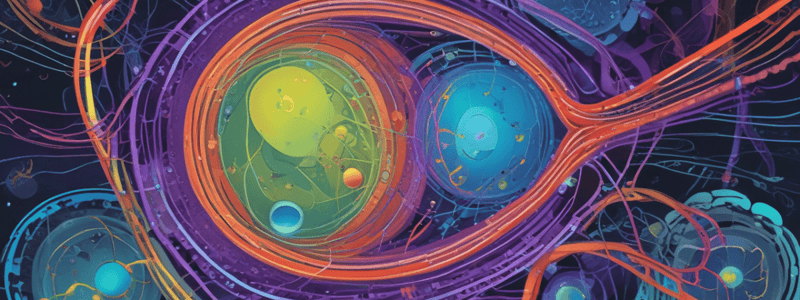Podcast
Questions and Answers
The nucleus contains the molecular machinery to replicate the DNA and to synthesize and process all types of RNA during the process of apoptosis.
The nucleus contains the molecular machinery to replicate the DNA and to synthesize and process all types of RNA during the process of apoptosis.
False (B)
Chromatin is a type of RNA found in the nucleolus.
Chromatin is a type of RNA found in the nucleolus.
False (B)
The nuclear envelope is a selectively permeable barrier between the nuclear and cytoplasmic compartments.
The nuclear envelope is a selectively permeable barrier between the nuclear and cytoplasmic compartments.
True (A)
The nuclear lamina is a type of chromatin found in the nucleolus.
The nuclear lamina is a type of chromatin found in the nucleolus.
Karyotyping is a process of studying the structure and function of the nuclear envelope.
Karyotyping is a process of studying the structure and function of the nuclear envelope.
The nucleolus is a region of chromatin where DNA replication occurs.
The nucleolus is a region of chromatin where DNA replication occurs.
Karyotyping involves the analysis of only 23 chromosomes per human cell.
Karyotyping involves the analysis of only 23 chromosomes per human cell.
During apoptosis, the nuclear envelope is broken down, releasing chromatin into the cytoplasm.
During apoptosis, the nuclear envelope is broken down, releasing chromatin into the cytoplasm.
Each nuclear pore complex regulates the movement of up to 1000 macromolecules per second between the nucleus and cytoplasm.
Each nuclear pore complex regulates the movement of up to 1000 macromolecules per second between the nucleus and cytoplasm.
The nucleolus is a region inside the nucleus where ribosomal subunits are synthesized.
The nucleolus is a region inside the nucleus where ribosomal subunits are synthesized.
Chromatin is composed of only DNA and histone proteins.
Chromatin is composed of only DNA and histone proteins.
After DNA replication, each chromosome consists of four identical chromatin units called chromatids.
After DNA replication, each chromosome consists of four identical chromatin units called chromatids.
In a cell's nucleus, the X chromosome is always transcriptionally active and visible.
In a cell's nucleus, the X chromosome is always transcriptionally active and visible.
The nucleolus is primarily responsible for the synthesis of ribosomal proteins.
The nucleolus is primarily responsible for the synthesis of ribosomal proteins.
The intense density of nucleoli is due to the presence of heterochromatin.
The intense density of nucleoli is due to the presence of heterochromatin.
The nuclear envelope is composed of euchromatin.
The nuclear envelope is composed of euchromatin.
The nucleolus is characterized by a diffuse, light-staining electron density.
The nucleolus is characterized by a diffuse, light-staining electron density.
Heterochromatin is typically found at the periphery of the nucleus, associated with the nuclear lamina.
Heterochromatin is typically found at the periphery of the nucleus, associated with the nuclear lamina.
What is the primary function of the nucleoporin complex in the nuclear envelope?
What is the primary function of the nucleoporin complex in the nuclear envelope?
What is the structural organization of chromatin in human cells?
What is the structural organization of chromatin in human cells?
What is the role of the nuclear lamina in non-dividing cells?
What is the role of the nuclear lamina in non-dividing cells?
What is the characteristic of the nuclear pore complexes in a growing cell?
What is the characteristic of the nuclear pore complexes in a growing cell?
What is the primary component of chromatin?
What is the primary component of chromatin?
What is the function of the nuclear envelope in a cell?
What is the function of the nuclear envelope in a cell?
What is the characteristic of chromatin in the nucleolus?
What is the characteristic of chromatin in the nucleolus?
What is the function of cohesion proteins in chromatin?
What is the function of cohesion proteins in chromatin?
What is the description of the nuclear envelope in a cell?
What is the description of the nuclear envelope in a cell?
What is the characteristic of the nuclear pore complexes in terms of symmetry?
What is the characteristic of the nuclear pore complexes in terms of symmetry?
Flashcards are hidden until you start studying



